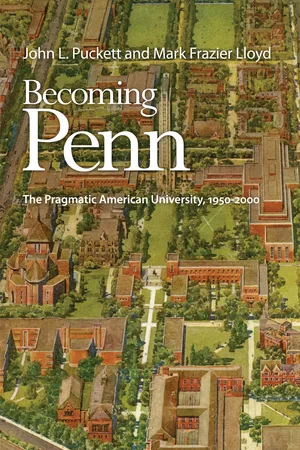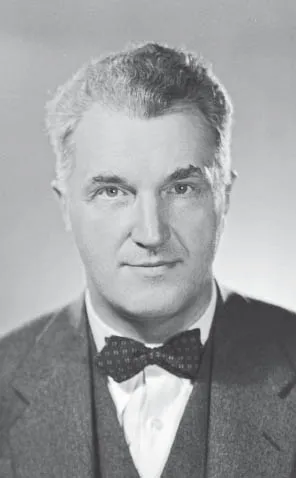![]() Part I The Builder
Part I The Builder![]()
1
Rise of the Urban Renewal University
In the spring of 1953 the University of Pennsylvania trustees appointed Gaylord P. Harnwell as the University’s fourth president. Since his arrival at Penn in 1936, Harnwell had held appointments as the Mary Amanda Wood Professor of Physics, chair of the Physics Department, and director of the Randal Morgan Laboratories. While on wartime leave from Penn from 1942 to 1946, he directed the University of California Division of War Research at Point Loma, San Diego, where sonar detection devices were developed for the U.S. Navy, with devastating consequences for Japanese submarines. Harnwell was an attractive candidate for the Penn presidency because of his reputation as a leading physicist, his success in strengthening the Physics Department, and his adroitness as a fund-raiser.1
From his office in 100 College Hall, Harnwell charted Penn’s rise to the status of a truly national university. During his long tenure from 1953 to 1970, he presided over the University’s transformation from a “sleepy” commuter campus with a regional orientation to a residential campus with a geographically diverse student body; from an institution landlocked by an increasingly congested urban environment to a tree-lined, pedestrian enclave with closed streets and quadrangles, buffered if not fully protected from the encroaching city.
Under Harnwell, Penn entered a fierce, unprecedented competition for wealth, power, and prestige among the nation’s postwar research universities. From the mid-1950s to 1970, U.S. research universities spent furiously and haphazardly on buildings, graduate programs, faculty salaries, and expanded administrative staffs to support their burgeoning research edifices. Bigness was deemed a blessing and a virtue; it was also a point of pride. Universities spent profligately on the strength of a buoyant national economy and the federal government’s Cold War commitment to basic and applied research. Flush with federal research dollars, Penn was no exception. The University was a prime beneficiary of the vastly accelerated flow of federal R & D grants in the wake of the Soviet launch of the Sputnik 1 communications satellite in 1957—the federal budget for basic research on the nation’s campuses tripled, with federal support rising from 43 percent to 79 percent of university research expenditures by 1964, a period of unprecedented federal largesse that the historian Roger Geiger calls “the golden age of academic science.”2 As the historian Walter McDougall puts it, the post-Sputnik acceleration of federal R & D dollars was “a saltation, an evolutionary leap in the relationship of the state to the creation of new knowledge.”3 Of particular importance to Penn, whose main strength was biomedical research, was the sponsorship of the National Institutes of Health (NIH), which, after 1958, provided both research dollars and infrastructural support for research facilities and PhD training.4 In 1969, Penn ranked seventeenth among universities and colleges in federally sponsored R & D, and ninth in the amount received from the Department of Health, Education, and Welfare.5 Harnwell’s administration more than tripled the value of the physical plant and quadrupled the University’s assets, building the endowment from $39 million to $200 million, increasing research and training contracts from $4 million to $45 million, and expanding total enrollments from fourteen thousand to nineteen thousand and the academic staff from twenty-six hundred to forty-six hundred.6
Harnwell’s greatest achievement, and his enduring legacy, was the indelible footprint he left on the landscape of West Philadelphia: the modern Penn campus, with manifold new buildings and radical renovations to house the burgeoning faculties and federally sponsored research projects, as well as the geographically diverse cohorts of undergraduates spawned first by the GI Bill, then by the middle-class baby boom. With his eye squarely on the future, Harnwell disentangled the University from the creep of heavily trafficked city streets, clanging trolley lines, and tawdry commercial establishments. He built the present-day West Central and West campuses, expanded the North Campus between 32nd and 38th streets, and established a sphere of influence between Chestnut Street and Lancaster Avenue. A consummate fund-raiser, he spearheaded a capital campaign in the 1960s that raised some $102 million, which helped fund twenty-five new buildings, twenty-eight endowed professorships, and significant growth in scholarships and student aid. Hailed as “the most successful chief executive the University has had since its inception in the eighteenth century,”7 Harnwell also founded a multi-institutional collaborative, the West Philadelphia Corporation, which sponsored development of an urban industrial park, the University City Science Center, which became a de facto component of Penn’s campus expansion in the Cold War era, though not without unintended, long-term consequences for the University’s community relations.
There were other contributions. Harnwell was Penn’s first president to solicit and organize alumni giving, traveling the world in search of alumni dollars. Under Harnwell, the University consulted with the shah of Iran to help create the American-style Pahlavi University in Shiraz—external development work that poured overseas petroleum money into the campus coffers. Joining other major university presidents, he stood firm against legislative assaults on academics’ freedom of speech during the McCarthy era, even though he loathed communism. In the 1960s, with his encouragement, Penn students gained a stronger voice in campus governance through the student-controlled Student Committee on Undergraduate Education (SCUE), whose recommendations prompted a reform of the undergraduate curriculum. Abolishing parietal rules and opening new dormitories as coeducational facilities by the end of the decade, the Harnwell campus largely divested itself of in loco parentis. The political conservatism of the mainstream student body, coupled with the tempered response of Harnwell and the trustees to student protest activity, mitigated the campus impact of the antiwar movement. Penn never experienced anything like the violence at Columbia, Wisconsin, or Berkeley.
Gaylord P. Harnwell. Collections of the University Archives and Records Center.
When Harnwell took office in 1953, the campus was still in physical disarray, not much improved since Paul Cret wrote his trenchant critique of campus planning in 1913. The diagonal of Woodland Avenue, part of the state highway system, still carried trolleys and automobiles past Logan and College halls. John Boyles’s iconic statue of Benjamin Franklin presided over the unpleasant thoroughfare. Locust Street crossed 36th Street just a short distance north of Woodland, contributing to a congested gaggle of people, stoplights, and machines. A foot-traffic analysis of these intersections from November 1946 shows about twenty-seven thousand pedestrian crossings for a three-day period.8 Student-oriented small businesses, many of them of low quality and shady appearance, stood cheek by jowl with campus buildings along Woodland and 36th and 37th streets. The celebrated urban planner Martin Meyerson recalled that when he arrived at Penn as an associate professor in the Department of City and Regional Planning in 1952, campus streets “were choked with traffic and crowded with noisily distracting commercial uses. Of course, as perhaps befits a ‘streetcar’ university, there were but few more buildings than there had been twenty-five years before, and what there were had drifted into obsolescence and even decay.”9 Indeed, between 1930 and 1950 only one new building was constructed: the Chemistry Department’s Cret Wing on Spruce Street.
View of College Hall and Woodland trolley lines, probably early 1950s. This photo shows John Boyles’s iconic statue of Benjamin Franklin, which the University acquired in 1939. The trolley lines were replaced by a subway-surface tunnel in 1955. Collections of the University Archives and Records Center.
View north from the old University Library toward Woodland Avenue and the trapezoidal block between 36th and 34th streets; College Hall at left, 1930. The row of buildings along Woodland marks the future site of the Van Pelt and Dietrich libraries. Collections of the University Archives and Records Center.
On a trapezoidal block across from College Hall on the north side of Woodland, aged brick and brownstone buildings housed sundry retail services, campus offices, and fraternity houses. Between 1952 and 1955, commensurate with Penn’s long-expressed need for a pedestrian-oriented campus and the urban renewal vision of Philadelphia’s reformist, pro-growth Democratic leaders and modernist city planners (1951–62), the city removed the trolley lines from Woodland Avenue and rerouted them into a subway tunnel under the Penn campus. In 1957 the City Council removed Woodland Avenue at Penn from the city plan altogether and deeded the roadbed to the University. (Penn would soon build a new library complex on the trapezoidal block opposite College Hall.) With the interior spaces of the historic campus core now fully controlled by Penn, the University joined hands with the Philadelphia Redevelopment Authority, the Philadelphia City Planning Commission, and the Pennsylvania General State Authority to take advantage of favorable urban renewal legislation and to launch a juggernaut building program that extended the campus west of the historic core to 40th Street and north above Walnut Street, demolishing old brownstones and displacing residents (mostly white) and merchants from 32nd to 40th streets.
The charter plan of the Great Expansion was the 1954–59 Educational Survey—to that time the largest self-study ever undertaken by an American university—which provided the academic rationale for Penn’s facilities planning after 1962.10 To fulfill the vision of the Educational Survey, Penn needed land. This was not “a general demand for space,” but rather a demand for “specific adjacent and adjoining areas.” Beyond this requirement, Penn, like the University of Chicago and Columbia University, demanded “a surrounding community compatible with the character of the educational institution itself.”11
Baby-boom cohorts fueled the Great Expansion. The salient demographics are these: 76.4 million babies, accounting for approximately two-fifths of the total U.S. population, were born between 1946 and 1964, with the college-age group counting 24.7 million in 1960.12 Between 1950 and 1970, the number of students in institutions of higher education soared from 2.66 million to 7.14 million. Driven by the GI Bill, the percentage of college students in the total population increased from 1.19 in 1946 to 1.76 in 1950, then leveled off until the baby boomers started to come of age. Between 1960 and 1970, the decade with the greatest concentration of college-age boomers, the number of higher education matriculates as a percentage of the total population increased from 1.79 to 3.51.13 Underpinning this extraordinary leap were a flush national economy, parents’ increasing recognition of the strong link between a college degree and social mobility, and the competitive growth of higher education institutions after midcentury. Keenly aware of the baby-boom phenomenon, Penn planners projected 41 percent growth in cumulative undergraduate student enrollments for the 1960s and a 65 percent increase for the two decades spanning 1960 to 1980. The University’s Integrated Development Plan of 1962 called for, among numerous other building projects, the construction of new dormitories to house the majority of the 7,800 fulltime students in the undergraduate colleges and 5,730 graduate and professional students expected by 1970.14
With the completion of the Harnwell-era building program in the early 1970s and the occupancy of myriad new academic buildings, research facilities, and high-rise dormitories, America’s first university in large part achieved its present size and physical form. “It is true of course that these were years of expansion everywhere,” Martin Meyerson would later write, “but at no ranking private institution was the expansion and differentiation as great as at Pennsylvania.”15
Giving particular attention to developments in the first decade of Harnwell’s presidency, this chapter looks closely at the early stages of the Great Expansion, when the Unive...



